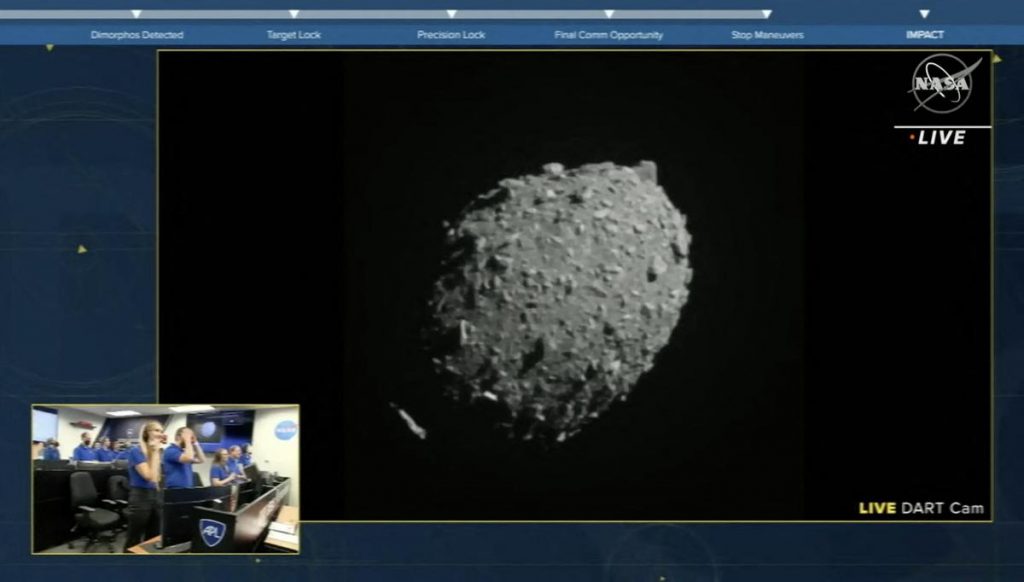DART (Double Asteroid Redirection Test)
What’s in News:
- DART (Double Asteroid Redirection Test) spacecraft collided with the space rock Dimorphos.
- NASA has confirmed that the collision of the 600 kilogram weighing DART, on the Dimorphos(Didymos B), about five billion kilogram in mass (orbiting around the 780 metres wide primary asteroid Didymos), has deflected the trajectory of the pair of space rocks.
- This kinetic impact technique is also known as the ‘kick’ method.
What is the working principle

- The plan is for DART to fly directly into Dimorphos at 15,000 miles per hour (24,000 kph), bumping it hard enough to shift its orbital track closer to its larger companion asteroid.
- Cameras on the impactor and on a briefcase-sized mini-spacecraft released from DART days in advance are designed to record the collision and send images back to Earth.
- DART’s own camera is expected to return pictures at the rate of one image per second during its final approach, with those images streaming live on NASA TV starting an hour before impact.
- The DART team said it expects to shorten the orbital track of Dimorphos, proving the exercise as a viable technique to deflect an asteroid on a collision course with Earth . A small nudge to an asteroid millions of miles away could be sufficient to safely reroute it away from the planet.
- The DART craft carried a high-resolution DRACO (Didymos Reconnaissance and Asteroid Camera for Optical navigation) camera to observe the collision and its consequences.

The need
- It could one day save humanity from a potential cataclysmic collision by safely deflecting a killer asteroid on its course towards earth.
- Dimorphos and Didymos are both tiny compared with the cataclysmic Chicxulub asteroid that struck Earth some 66 million years ago, wiping out about three-quarters of the world’s plant and animal species including the dinosaurs.
- It could also fuel space mining technologies and unleash the space economy in decades to come. For developing green energy technologies — electric vehicles, solar panels, wind turbines, and energy storage devices – and ushering in the low carbon economy of the future, rare earth elements such as yttrium, niobium, rhodium, palladium, osmium, iridium and scandium are critical. They are short in supply, and asteroid mining, it is believed, could solve the rare earth supply problem.
What are asteroids?
- Leftover materials from the formation of the sun, earth and planets, through the accretion and agglomeration of giant gas and rocks, are scattered as comets, asteroids and meteoroids in the solar system. Most rocks are so small that they burn up completely in the atmosphere due to frictional heating. If they are large enough, the charred piece falls through as a meteorite.
Who else is developing this technology
- China is set to deflect a 40m diameter earth-crossing asteroid called 2020 PN1 sometime in 2026.
Other Asteroid related missions
- NASA launched a probe on a voyage to the Trojan asteroid clusters orbiting near Jupiter, while the grab-and-go spacecraft OSIRIS-REx is on its way back to Earth with a sample collected in October 2020 from the asteroid Bennu.
- The European Space Agency is set to launch the Hera mission in 2024, arriving at Didymos in early 2027 to take a close look at the remaining impact effects.
Additional Information
- Meteoroid -A meteoroid is a small rocky or metallic body in outer space.
- Asteroid -Asteroids are small, rocky objects that orbit the Sun. Although asteroids orbit the Sun like planets, they are much smaller than planets
- Comet – A comet is an icy, small Solar System body that, when passing close to the Sun, warms and begins to release gases, a process called outgassing. When a comet comes close to the Sun, the ices sublimate (go directly from the solid to the gas phase) and form, along with entrained dust particles, a bright outflowing atmosphere around the comet nucleus known as a coma.
- Meteorite– A meteorite is a solid piece of debris from an object, such as a comet, asteroid, or meteoroid, that originates in outer space and survives its passage through the atmosphere to reach the surface of a planet or moon
- References:
- https://www.thehindu.com/sci-tech/science/why-is-a-nasa-spacecraft-crashing-into-an-asteroid/article65925713.ece
- https://www.thehindu.com/sci-tech/science/nasas-exploration-of-the-asteroid-system/article65930806.ece
- https://www.thehindu.com/sci-tech/science/nasas-asteroid-deflecting-dart-spacecraft-nears-planned-impact-with-its-target/article65937616.ece
- https://www.thehindu.com/sci-tech/science/explained-the-nasa-spacecraft-asteroid-collision/article65943566.ece
Subscribe
Login
0 Comments
